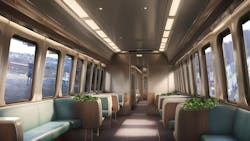Seeing the commute differently: Designing transit spaces that boost well-being
I take the train almost every day. It’s part of my routine—a time to read, think or just mentally prepare for the day ahead. Some days, the ride feels calm and quiet, like a welcome pause. Other days, it’s less pleasant; not necessarily because of delays or crowding, but because of the space itself. Maybe it’s not as clean, maybe the odor lingers a bit too long, maybe the lighting and ambience feels off in a way I can’t quite name.
But there’s one moment I’ll never forget. I saw a rider seated near the middle of the train, awkwardly holding a full-sized bicycle. There was no rack, no designated space, just him trying not to knock over other passengers every time the train shifted. That image stuck with me. It raised a simple but overlooked question: How do the spaces we design for public transportation affect the people who use them?
What we found reinforces something important. Thoughtful design isn’t just about aesthetics. It shapes experience, comfort, emotion and ultimately, how likely people are to choose public transportation in the first place.
The idea that our surroundings influence our experiences isn’t new—not to me and not to the broader research community. For years, studies on the built environment have examined how buildings, public spaces and urban design shape the way we feel, think and behave. But this time, the perspective was different. Instead of focusing on cities or architecture, we turned our attention to something more often treated as purely functional: the interior of a train cabin.
What happens when we start thinking of public transportation as a built environment, one that passengers inhabit, even if only briefly? That question led to a research project I conducted with colleagues at Villanova University. Elizabeth Pantesco, Ph.D., Yasaman Hakiminejad and I explored the psychological and visual impacts of transit cabin designs. We wanted to understand not just how people say they feel in different transit environments, but how they interact with them in real time.
How transit design shapes well-being
We designed a study that exposed 304 participants to six images of public transportation cabin interiors, each representing a different design condition. We used artificial intelligence (AI) to create these cabins together with graphic editing. These included a current baseline cabin from a U.S. regional train, a poorly maintained version (complete with visible trash using AI), an aesthetically enhanced version, one that included workspace features, one designed for bike storage and one incorporating natural, biophilic elements like indoor plants.
Participants were asked to imagine each design as the train cabin they ride daily. For each one, we collected a range of well-being responses such as how stressed or relaxed they felt, how positive or negative their emotions were, how fast they perceived the passage of time in these spaces and even how creative they imagined themselves feeling in that space. We also asked about comfort, safety, cleanliness, perceived price and whether they’d recommend the cabin to others.
The findings were clear. Cabins with enhanced aesthetics, added workspaces or natural elements significantly improved well-being and perceptions of the ride. The biophilic cabin—with plants and calming colors—produced the highest boost in positive emotions, reduced stress and increased feelings of creativity. Meanwhile, the poorly maintained cabin lowered every single measure, from stress to safety to recommendation.
What the eyes reveal
While participants rated each cabin design, we simultaneously tracked their eye movements using webcam-based eye-tracking technology. This gave us a unique window into how people visually engage with each environment, how quickly they focused on key areas, where their eyes lingered and how structured or scattered their gaze patterns were. One of the core metrics we analyzed was fixation locations, the specific points on the image where a participant's gaze rested. These reveal which features draw the most attention and how people visually navigate the space.
Here, too, the results aligned with our well-being findings. People oriented faster and looked more deliberately at well-designed cabins—especially those with greenery, workspaces or functional layouts. Their gaze patterns were more structured, suggesting these spaces required less cognitive effort to navigate. The poorly maintained cabin, on the other hand, led to more scattered, unfocused eye movements, consistent with discomfort or mental overload.
We also found that demographic and travel-related factors played a role. For example, non-white participants showed shorter visual fixations in both the enhanced and poorly maintained cabins, which raises important questions about inclusivity in environmental design. Riders who rarely used public transportation responded more quickly to enhanced visual features, suggesting thoughtful design could help attract new or infrequent riders.
Design is not an afterthought
Together, the well-being ratings and eye-tracking data told a coherent story: the design of public transportation environments matters — a lot.
It influences how we feel, how we perceive safety, how we experience time and even how likely we are to recommend the service to others. Yet, in many systems, cabin design is treated as secondary—an afterthought to scheduling, infrastructure or fare systems.
But if we want more people to ride public transit, not just because it’s practical or affordable, but because it’s enjoyable and human-centered, then we need to shift that mindset. Design is not just about surfaces or seats. It’s about emotional experience, dignity and belonging.
Toward a human-centered transit future
My daily commute is what inspired this research. That one passenger balancing a bike—the awkwardness, the lack of consideration for real user needs—helped bring it into focus. We now have data that shows just how deeply cabin environments impact passengers. We’ve shown that features like bike accommodations, workspace zones and biophilic design can improve emotional responses, visual engagement and perceptions of the ride—all of which translate into stronger loyalty and higher ridership.
These aren’t expensive overhauls. Some are simple design decisions guided by evidence. Transit agencies and designers now have a unique opportunity to build systems that are not just operationally effective, but emotionally intelligent.
When we design for the person, not just the passenger, we create spaces that do more than move people. We create environments that make people feel better, think more clearly and maybe even look forward to the ride; we create human-centered spaces.
About the Author

Arash Tavakoli
Assistant Professor, Villanova University
Arash Tavakoli, Ph.D., is an assistant professor of civil and environmental engineering at Villanova University and the director of the Human-Centered Cities Lab. His research focuses on the intersection of transportation engineering, human behavior and urban design—using technologies such as virtual reality, physiological sensing and artificial intelligence to reimagine how people interact with infrastructure. Through his work, he aims to build safer, human-focused transportation systems for the cities of tomorrow.
